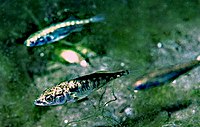
Photo from wikipedia
Time is considered a resource in limited supply, and temporal niche separation is one of the most common strategies that allow ecologically similar species to live in sympatry. Mechanisms of… Click to show full abstract
Time is considered a resource in limited supply, and temporal niche separation is one of the most common strategies that allow ecologically similar species to live in sympatry. Mechanisms of temporal niche separation are understudied especially in cryptic animals due to logistical problems in gathering adequate data. Using high-frequency accelerometers attached to radio-collars, we investigated whether the ecologically similar lemurs Avahi meridionalis and Lepilemur fleuretae in the lowland rainforest of Tsitongambarika, south-eastern Madagascar, show temporal niche separation. Accelerometers stored data with a frequency of 1 Hz for a total of 71 days on three individuals of A. meridionalis and three individuals of L. fleuretae. We extrapolated motor activity patterns via the unsupervised learning algorithm expectation maximisation and validated the results with systematic behavioural observations. Avahi meridionalis showed peaks of activity at twilights with low but consistent activity during the day, while L. fleuretae exhibited more activity in the central hours of the night. Both lemur species had their activity pattern entrained by photoperiodic variations. The pair-living A. meridionalis was found to be lunarphilic while the solitary-living L. fleuretae was lunarphobic. We suggest that these activity differences were advantageous to minimise feeding competition, as an anti-predator strategy, and/or for dietary-related benefits. These findings demonstrate a fine-tuned temporal partitioning in sympatric, ecologically similar lemur species and support the idea that an activity spread over the 24-h, defined here as cathemerality sensu lato, is more common than previously thought in lemurs.Significance statementEcologically similar species may exhibit temporal niche partitioning and separate their peaks of activity when co-occurring in an area. We show for the first time that the mainly nocturnal genus Avahi can exhibit high crepuscular activity with low but consistent bouts of activity (up to 44.6% of daily activity) during the day. We defined this activity as cathemerality sensu lato as opposed to the cathemerality sensu stricto observed in Eulemur sp. We suggest that this flexible activity may be advantageous for the species to minimise feeding competition and predatory pressure, and/or to provide dietary-related benefits. This finding in the secondary nocturnal genus Avahi supports the idea that activity patterns in lemurs are graded and traditional categorisations are inadequate.
Journal Title: Behavioral Ecology and Sociobiology
Year Published: 2019
Link to full text (if available)
Share on Social Media: Sign Up to like & get
recommendations!